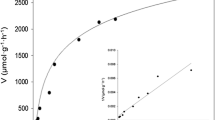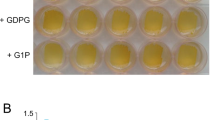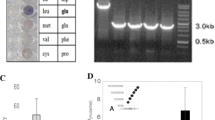Abstract
Resting cells ofFusobacterium nucleatum ATCC 10953, when provided with glutamic acid (Na+ salt) as fermentable energy source, rapidly accumulated [14C]glucose, from the medium. Sugar accumulation was not observed when Na+ glutamate was replaced by ammonium glutamate. However, addition of Na+ (chloride) to the latter system elicited uptake of [14C]glucose by the organism. Of other monovalent cations tested, only Li+ was found to be slightly stimulatory, but K+, Rb+, and Cs+ ions were ineffective. For determination of the role(s) of Na+ in sugar accumulation, the transport of [14C]glucose and [14C]glutamic acid by the cells was studied independently, with lysine as an alternate (and Na+-independent) energy source. In the presence of lysine, cells ofF. nucleatum 10953 accumulated [14C]glucose from a Na+-free medium, but, in contrast, uptake and fermentation of [14C]glutamic acid was Na+-dependent. The glucose transport system is Na+-independent. However, our data indicate dual role(s) for Na+ in the transport and intracellular metabolism of glutamic acid. The Na+-dependent glutamate fermentation pathway provides the necessary energy for active transport of glucose by the resting cell.
Similar content being viewed by others
Literature Cited
Barker HA (1981) Amino acid degradation by anaerobic bacteria. Annu Rev Biochem 50:23–40
Barker HA, Kahn JM, Hedrick L (1982) Pathway of lysine degradation inFusobacterium nucleatum. J Bacteriol 152:201–207
Buckel W (1986) Biotin-dependent decarboxylases as bacterial sodium pumps: purification and reconstitution of glutaconyl-CoA decarboxylase fromAcidaminococcus fermentans. Methods Enzymol 125:547–558
Buckel W, Barker HA (1974) Two pathways of glutamate fermentation by anaerobic bacteria. J Bacteriol 117:1248–1260
Buckel W, Semmler R (1982) A biotin-dependent sodium pump: glutaconyl-CoA decarboxylase fromAcidaminococcus fermentans. FEBS Lett 148:35–38
Buckel W, Semmler R (1983) Purification, characterization and reconstitution of glutaconyl-CoA decarboxylase, a biotin-dependent sodium pump from anaerobic bacteria. Eur J Biochem 136:427–434
Coles Jr RS (1977) Glucose utilization by resting cells ofFusobacterium polymorphum. Arch Oral Biol 22:87–90
Dimroth P (1987) Sodium ion transport decarboxylases and other aspects, of sodium ion cycling in bacteria. Microbiol Rev 51:320–340
Frank L, Hopkins I (1969) Sodium-stimulated transport of glutamate inEscherichia, coli. J Bacteriol 100:329–336
Fujimura T, Yamato I, Anraku Y (1983) Mechanism of glutamate transport inEscherichia coli B. I. Proton-dependent and sodium ion dependent binding of glutamate to a glutamate carrier in the cytoplasmic membrane. Biochemistry 22:1954–1959
Gharbia SE, Shah HN (1988) Glucose utilization and growth response to protein hydrolysates byFusobacterium species. Curr Microbiol 17:229–234
Jackins HC, Barker HA (1951) Fermentative processes of the Fusiform bacteria. J Bacteriol 61:101–114
Loesche WJ, Gibbons RJ (1968) Amino acid fermentation byFusobacterium nucleatum. Arch Oral Biol 13:191–202
MacDonald RE, Lanyi JK, Greene RV (1977) Sodium-stimulated glutamate uptake in membrane vesicles ofEscherichia coli: the role of ion gradients. Proc Natl Acad Sci USA 74:3167–3170
Moore WEC, Holdeman LV, Smibert RM, Good IJ, Burmeister JA, Palcanis KG, Ranney RR (1982) Bacteriology of experimental gingivitis in young adult humans. Infect Immun 38:651–667
Moore WEC, Holdeman LV, Smibert RM, Hash DE, Burmeister JA, Ranney RR (1982) Bacteriology of severe periodontitis in young adult humans. Infect Immun 38:1137–1148
Moore WEC, Holdeman LV, Kelley W (1984) GenusFusobacteria Knorr 1922,. In: Krieg NR, Holt JC (eds) Bergey's manual of systematic bacteriology, vol. 1, 9th edn. Baltimore: Williams and Wilkins, pp 631–637
Nakatani Y, Fujioka M, Higashino K (1972) Enzymatic determination ofl-lysine in biological materials. Anal Biochem 49:225–231
Robrish SA, Thompson J (1988) Suppression of polyglucose degradation inFusobacterium nucleatum ATCC 10953 by amino acids FEMS Microbiol Lett 55:29–34
Robrish SA, Oliver C, Thompson J (1987) Amino acid-dependent transport of sugars byFusobacterium nucleatum ATCC 10953. J Bacteriol 169:3891–3897
Rohde M, Mayer F, Dutscho R, Wohlfarth G, Buckel W (1988) Immunocytochemical localization of two key enzymes of the 2-hydroxyglutarate pathway of glutamate fermentation inAcidaminococcus fermentans. Arch Microbiol 150:504–508
Slots J (1977) The predominant cultivable microflora of advanced periodontitis. Scand J Dent Res 85:114–121
Stock J, Roseman S (1971) A sodium-dependent cotransport system in bacteria. Biochem Biophys Res Commun 44:132–138
Thompson J, MacLeod RA (1971) Functions of Na+ and K+ in the active transport of α-aminoisobutyric acid in a marine pseudomonad. J Biol Chem 246:4066–4074
Thompson J, MacLeod RA (1973) Na+ and K+ gradients and α-aminoisobutyric acid transport in a marine pseudomonad. J Biol Chem 248:7106–7111
Thompson J, Curtis MA, Miller SPF (1986) N5-(1-Carboxyethyl)-ornithine, a new amino acid from the intracellular pool ofStreptococcus lactis. J Bacteriol 167:522–529
Tokuda H, Kaback HR (1977) Sodium-dependent methyl 1-thio-β-d-galactopyranoside transport in membrane vesicles isolated fromSalmonella typhimurium. Biochemistry 16:2130–2136
Tsuchiya T, Raven J, Wilson TH (1977) Co-transport of Na+ and methyl-β-d-thiogalactopyranoside mediated by the melibiose transport system ofEscherichia coli. Biochem Biophys Res Commun 76:26–31
Westlake DWS, Horler DF, McConnell WB (1967) The effect of sodium on the fermentation of glutamic acid byPeptococcus aerogenes. Biochem Biophys Res Commun 26:461–465
Wohlfarth G, Buckel W (1985) A sodium ion gradient as energy source forPeptostreptococcus asaccharolyticus. Arch Microbiol 142:128–135
Author information
Authors and Affiliations
Rights and permissions
About this article
Cite this article
Robrish, S.A., Thompson, J. Na+ requirement for glutamate-dependent sugar transport byFusobacterium nucleatum ATCC 10953. Current Microbiology 19, 329–334 (1989). https://doi.org/10.1007/BF01570110
Issue Date:
DOI: https://doi.org/10.1007/BF01570110




